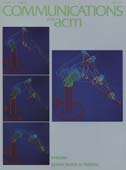June 1986 - Vol. 29 No. 6

Features
Factory automation and robotics
Selected from papers presented at the Symposium on Factory Automation and Robotics held September 9-11, 1985, at New York University
The impact of robotics on computer science
The rapid development of robotics and the resulting need for computer scientists to be better trained in traditional mathematics necessitate changes in computer science curricula.
Research on legged machines can lead to the construction of useful legged vehicles and help us to understand legged locomotion in animals.
Opportunities for research on numerical control machining
Numerical control (NC) machining could be reinvigorated by adapting robotic software technology. Regrettably, pressures are mounting in industry to constrain robots to NC standards, and the academic community views NC as an obsolete, solved problem, with little remaining scholarly challenge. Grossman examines the current status of APT, an NC language, and proposes the merging of APT with a modern robotics language.
Normalization of relations and PROLOG
A program for the normalization of relations that is written in Prolog has several advantages relative to programs written in conventional programming languages: notably, conciseness and clarity. The program presented here implements several normalization algorithms and is suitable for the interactive design of small database applications and as a teaching aid.
Impact of the technological environment on programmer/analyst job outcomes
Recent research has shown that key DP/IS personnel job outcomes (e.g., turnover, organizational commitment, job satisfaction) are affected by job design, leadership characteristics, and role variables. This study investigates another class of variables, the technological environment faced by DP/IS personnel, that might impact these job outcomes. The technological environment includes (1) development methodologies employed, (2) project teams and reporting relationships, and (3) work characteristics. Variables from all classes were found to impact DP/IS job outcomes. Over 11 percent of the variance in DP/IS job satisfaction is explained by these variables.



